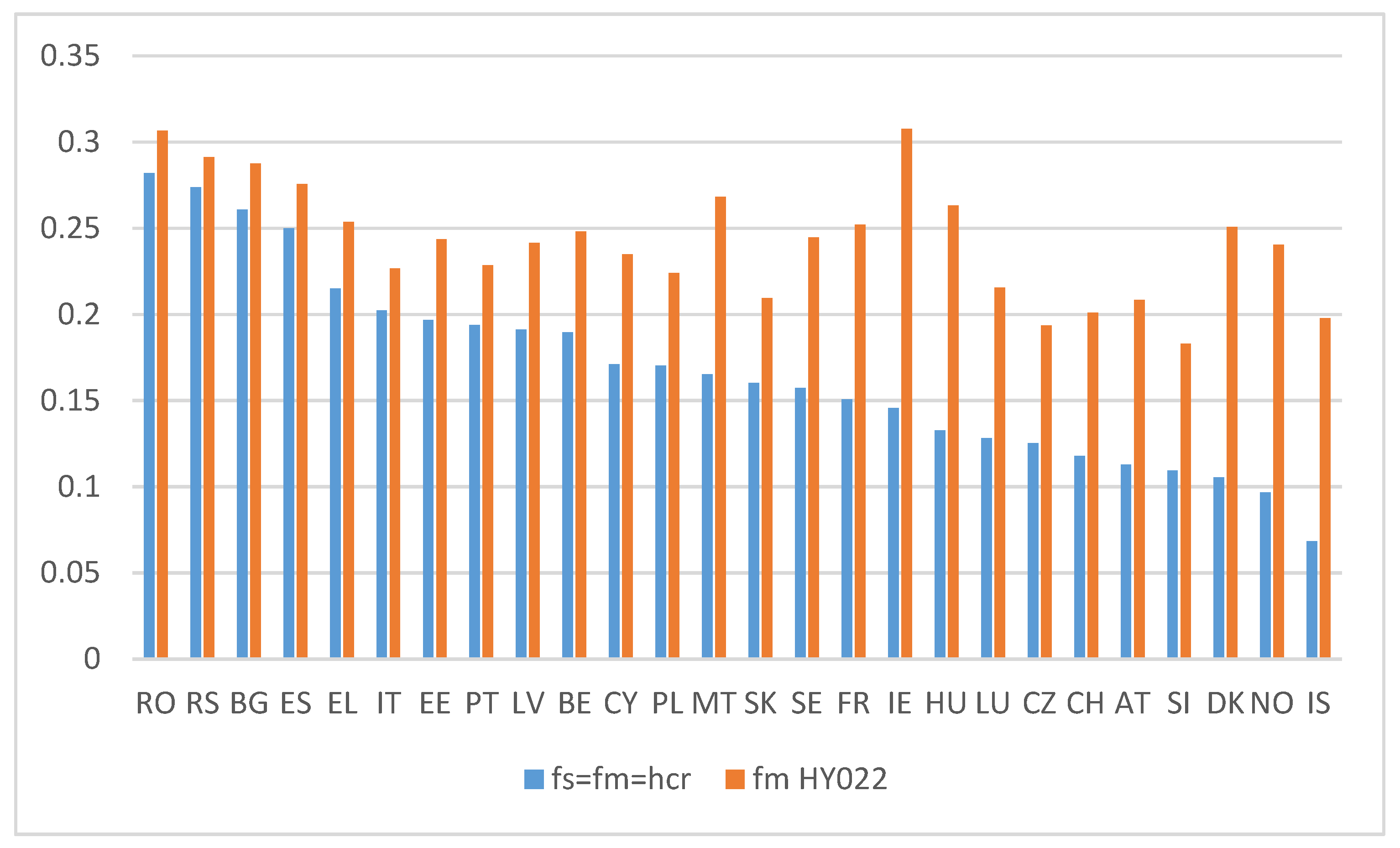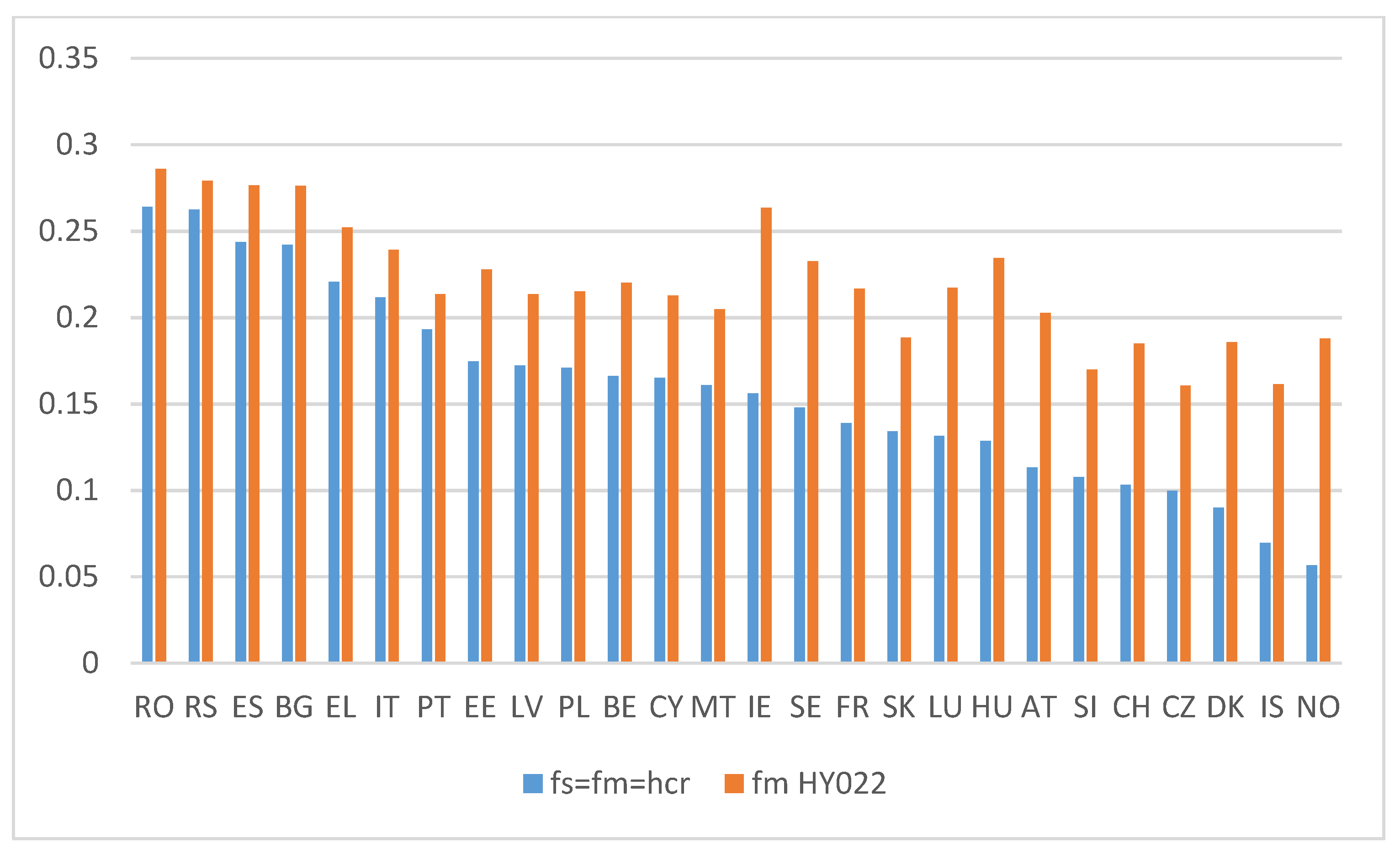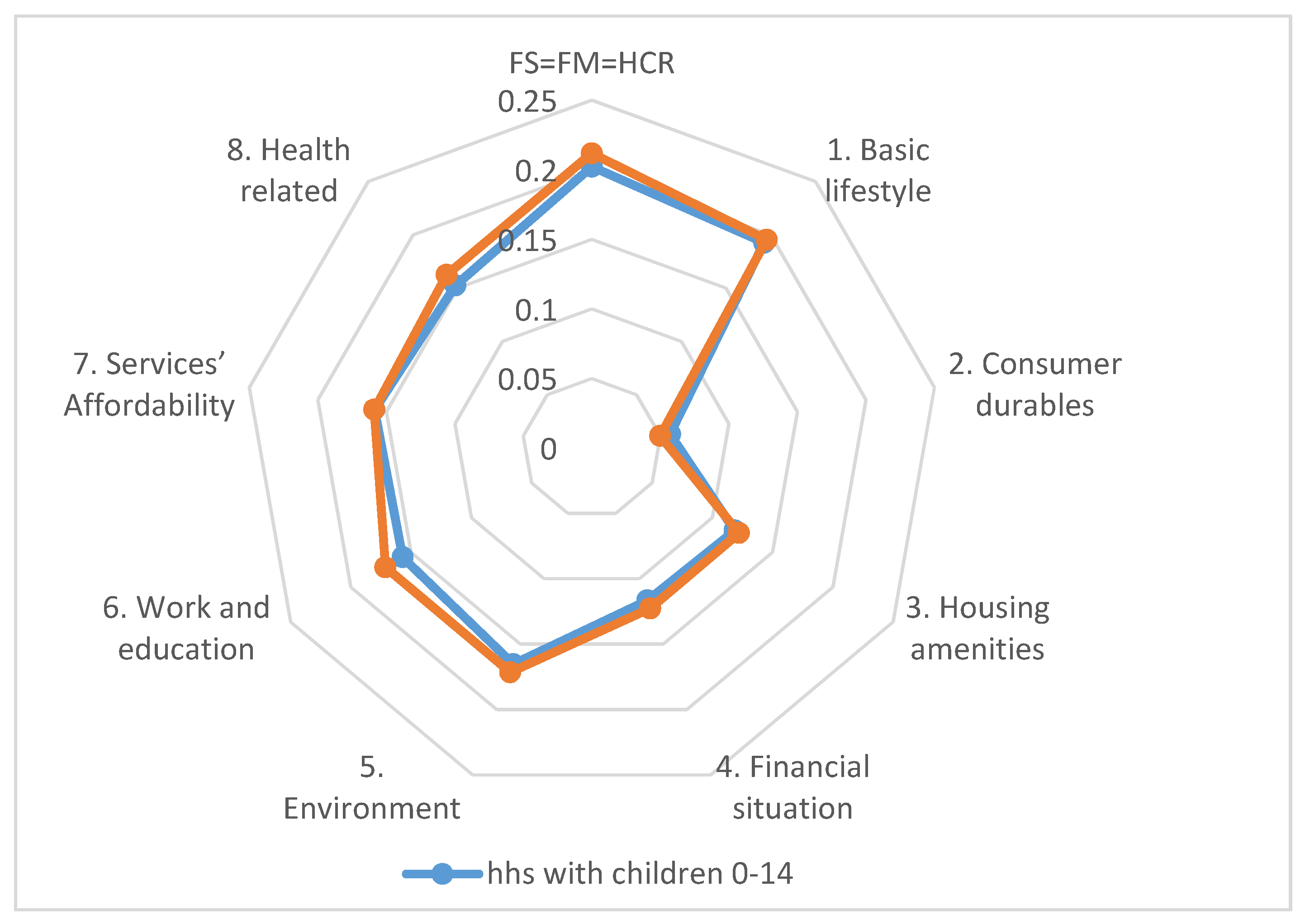The Heavy Burden of “Dependent Children”: An Italian Story
Abstract
:1. Introduction
2. Data and Methodology
2.1. Data
2.2. Methods
- Identification of items to describe non-monetary poverty and their transformation into the range [0, 1];
- Development of exploratory and confirmatory factor analysis to identify the hidden dimensions of poverty;
- Construction of the weights to be assigned within each dimension, based on the dispersion of the item and the correlation with other items belonging to the same dimension;
- Computation of the score within each dimension as a weighted mean of the items in the dimension, and finally, computation of the overall score as a simple average of the dimension scores.
3. Results
3.1. Fuzzy Monetary Measures
3.2. Fuzzy Supplementary Measures and Their Precision
3.3. Comparison of the Two Subpopulations
3.4. Focus on Italy
4. Final Remarks
Author Contributions
Funding
Institutional Review Board Statement
Informed Consent Statement
Data Availability Statement
Conflicts of Interest
References
- Eurostat. Children at Risk of Poverty or Social Exclusion. 2020. Available online: https://ec.europa.eu/eurostat/statistics-explained/index.php?title=Children_at_risk_of_poverty_or_social_exclusion (accessed on 23 October 2020).
- European Commission. 2016 EU-SILC Module “Access to Services”; Eurostat: Luxembourg, 2018. [Google Scholar]
- Zadeh, L.A. Fuzzy sets. Inf. Control 1965, 8, 338–353. [Google Scholar] [CrossRef] [Green Version]
- Verma, V.; Lemmi, A.; Betti, G.; Gagliardi, F.; Piacentini, M. How precise are poverty measures estimated at the regional level? Reg. Sci. Urban Econ. 2017, 66, 175–184. [Google Scholar] [CrossRef]
- Betti, G.; Gagliardi, F.; Verma, V. Simplified Jackknife Variance Estimates for Fuzzy Measures of Multidimensional Poverty. Int. Stat. Rev. 2018, 86, 68–86. [Google Scholar] [CrossRef] [Green Version]
- Betti, G.; Verma, V. Fuzzy measures of the incidence of relative poverty and deprivation: A multi-dimensional perspective. Stat. Methods Appl. 2008, 17, 225–250. [Google Scholar] [CrossRef]
- Betti, G.; Gagliardi, F.; Lemmi, A.; Verma, V. Comparative measures of multidimensional deprivation in the European Union. Empir. Econ. 2015, 49, 1071–1100. [Google Scholar] [CrossRef]
- Cheli, B.; Lemmi, A. A Totally Fuzzy and Relative Approach to the Multidimensional Analysis of Poverty. Econ. Notes 1995, 24, 115–134. [Google Scholar]
- Betti, G.; Cheli, B.; Lemmi, A.; Verma, V. Multidimensional and Longitudinal Poverty: An Integrated Fuzzy Approach. In Fuzzy Set Approach to Multidimensional Poverty Measurement; Lemmi, A., Betti, G., Eds.; Springer: New York, NY, USA, 2006; pp. 111–137. [Google Scholar]
- Baldini, M.; Gallo, G.; Reverberi, M.; Trapani, A. Social Transfers and Poverty in Europe: Comparing Social Exclusion and Targeting Across Welfare Regimes; Center for the Analysis of Public Policies (CAPP) 0145; Università di Modena e Reggio Emilia: Modena, Italy, 2016. [Google Scholar]
- Verma, V. Sampling Methods, Training Handbook; Statistical Institute for Asia and the Pacific: Tokyo, Japan, 1991. [Google Scholar]
- Kish, L. Survey Sampling; Wiley: New York, NY, USA, 1995. [Google Scholar]
- Verma, V.; Betti, G.; Gagliardi, F. An Assessment of Survey Errors in EU-SILC; Eurostat Methodologies and Working Papers; Eurostat: Luxembourg, 2010. [Google Scholar]
- UNECE. Poverty Measurement Guide to Data Disaggregation; United Nations: New York, NY, USA; Geneva, Switzerland, 2020. [Google Scholar]
- Rosina, A. I neet In Italia Dati, Esperienze, Indicazioni per Efficaci Politiche di Attivazione; StartNet—Network Transizione Scuola-lavoro: Roma, Italy, 2020. [Google Scholar]
- Natali, L.; Saraceno, C. The Impact of the Great Recession on Child Poverty: The case of Italy. In Children of Austerity: Impact of the Great Recession on Child Poverty in Rich Countries; Cantillon, B., Chzhen, Y., Handa, S., Nolan, B., Eds.; Oxford Press: Oxford, UK, 2017; pp. 170–190. [Google Scholar]



| Number of Households (% of Total Households) | Number of Individuals (% of Total Individuals) | |
|---|---|---|
| Households with children aged 0–14 | 42,817 (22.6%) | 172,478 (37.0%) |
| Households with dependent children | 52,871 (27.9%) | 214,549 (46.1%) |
| 1. Basic Lifestyle | 2. Consumer Durables | 3. Housing Amenities | 4. Financial Situation | 5. Environment | 6. Work and Education | 7. Service Affordability | 8. Health Related |
|---|---|---|---|---|---|---|---|
| Meals with meat, fish, or chicken; | Car; | Bath or Shower; | Inability to cope with unexpected expenses; | Crime, violence, vandalism; | Early school leavers; | Affordability of childcare services; | General health; |
| Household adequately warm; | PC; | Indoor flushing toilet; | Arrears on mortgage or rent payments; | Pollution; | Low education; | Affordability of formal education; | Chronic illness; |
| Holiday away from home; | Telephone; | Leaking roof and damp; | Arrears on utility bills; | Noise. | Worklessness; | Affordability of healthcare services. | Mobility restriction; |
| Ability to make ends meet | Washing Machine; | Rooms too dark; | Arrears on hire purchase instalments; | Duration of unemployment. | Unmet need for medical exam; | ||
| TV | Overcrowded house (NEW). | Financial burden of total housing cost (NEW). | Unmet need for dental exam. |
| Households with Children Aged 0–14 | Households with Dependent Children | |
|---|---|---|
| Goodness of fit (GFI) a | 0.928 | 0.929 |
| Adjusted GFI b | 0.913 | 0.914 |
| Parsimonious GFI c | 0.811 | 0.811 |
| Std. Root Mean Square Residual d | 0.056 | 0.058 |
| RMSEA e | 0.049 | 0.049 |
| Country | Measure | Estimate | Standard Error | CI_Min | CI_Max | Cv |
|---|---|---|---|---|---|---|
| AT | FS | 0.113 | 0.005 | 0.104 | 0.122 | 4.0% |
| AT | FS1 | 0.097 | 0.004 | 0.088 | 0.106 | 4.6% |
| AT | FS2 | 0.056 | 0.004 | 0.048 | 0.063 | 6.7% |
| AT | FS3 | 0.079 | 0.004 | 0.071 | 0.087 | 5.1% |
| AT | FS4 | 0.084 | 0.004 | 0.076 | 0.093 | 4.9% |
| AT | FS5 | 0.097 | 0.005 | 0.088 | 0.106 | 4.8% |
| AT | FS6 | 0.099 | 0.004 | 0.090 | 0.108 | 4.4% |
| AT | FS7 | 0.107 | 0.005 | 0.098 | 0.116 | 4.2% |
| AT | FS8 | 0.066 | 0.004 | 0.059 | 0.074 | 5.7% |
| BE | FS | 0.190 | 0.006 | 0.179 | 0.201 | 2.9% |
| BE | FS1 | 0.156 | 0.006 | 0.145 | 0.166 | 3.5% |
| BE | FS2 | 0.062 | 0.004 | 0.054 | 0.071 | 7.1% |
| BE | FS3 | 0.116 | 0.005 | 0.106 | 0.125 | 4.3% |
| BE | FS4 | 0.124 | 0.005 | 0.114 | 0.133 | 3.9% |
| BE | FS5 | 0.159 | 0.006 | 0.147 | 0.171 | 3.9% |
| BE | FS6 | 0.150 | 0.005 | 0.140 | 0.160 | 3.5% |
| BE | FS7 | 0.165 | 0.005 | 0.155 | 0.176 | 3.3% |
| BE | FS8 | 0.145 | 0.005 | 0.135 | 0.156 | 3.7% |
| PL | FS | 0.170 | 0.003 | 0.164 | 0.176 | 1.7% |
| PL | FS1 | 0.129 | 0.003 | 0.123 | 0.134 | 2.2% |
| PL | FS2 | 0.055 | 0.002 | 0.050 | 0.059 | 4.1% |
| PL | FS3 | 0.097 | 0.003 | 0.092 | 0.102 | 2.7% |
| PL | FS4 | 0.112 | 0.003 | 0.107 | 0.118 | 2.4% |
| PL | FS5 | 0.114 | 0.003 | 0.109 | 0.120 | 2.5% |
| PL | FS6 | 0.145 | 0.003 | 0.139 | 0.150 | 2.0% |
| PL | FS7 | 0.149 | 0.003 | 0.144 | 0.155 | 1.9% |
| PL | FS8 | 0.154 | 0.003 | 0.148 | 0.160 | 2.0% |
| Country | Measure | Estimate | Standard Error | CI_Min | CI_Max | Cv |
|---|---|---|---|---|---|---|
| AT | FS | 0.113 | 0.004 | 0.105 | 0.122 | 3.7% |
| AT | FS1 | 0.094 | 0.004 | 0.085 | 0.102 | 4.4% |
| AT | FS2 | 0.049 | 0.003 | 0.042 | 0.056 | 7.1% |
| AT | FS3 | 0.078 | 0.004 | 0.070 | 0.085 | 4.8% |
| AT | FS4 | 0.083 | 0.004 | 0.076 | 0.091 | 4.6% |
| AT | FS5 | 0.094 | 0.004 | 0.086 | 0.102 | 4.5% |
| AT | FS6 | 0.100 | 0.004 | 0.092 | 0.108 | 4.1% |
| AT | FS7 | 0.107 | 0.004 | 0.099 | 0.115 | 3.9% |
| AT | FS8 | 0.064 | 0.003 | 0.057 | 0.071 | 5.4% |
| BE | FS | 0.166 | 0.005 | 0.156 | 0.176 | 3.0% |
| BE | FS1 | 0.138 | 0.005 | 0.128 | 0.148 | 3.6% |
| BE | FS2 | 0.047 | 0.004 | 0.040 | 0.054 | 8.0% |
| BE | FS3 | 0.102 | 0.004 | 0.093 | 0.110 | 4.3% |
| BE | FS4 | 0.110 | 0.004 | 0.102 | 0.118 | 3.9% |
| BE | FS5 | 0.142 | 0.005 | 0.131 | 0.152 | 3.8% |
| BE | FS6 | 0.136 | 0.005 | 0.127 | 0.146 | 3.5% |
| BE | FS7 | 0.146 | 0.005 | 0.136 | 0.155 | 3.3% |
| BE | FS8 | 0.131 | 0.005 | 0.121 | 0.140 | 3.7% |
| PL | FS | 0.171 | 0.003 | 0.166 | 0.176 | 1.6% |
| PL | FS1 | 0.126 | 0.003 | 0.121 | 0.131 | 2.0% |
| PL | FS2 | 0.052 | 0.002 | 0.048 | 0.056 | 3.9% |
| PL | FS3 | 0.097 | 0.002 | 0.092 | 0.101 | 2.5% |
| PL | FS4 | 0.109 | 0.002 | 0.104 | 0.114 | 2.3% |
| PL | FS5 | 0.111 | 0.003 | 0.106 | 0.116 | 2.3% |
| PL | FS6 | 0.142 | 0.003 | 0.137 | 0.147 | 1.8% |
| PL | FS7 | 0.150 | 0.003 | 0.145 | 0.155 | 1.7% |
| PL | FS8 | 0.153 | 0.003 | 0.148 | 0.159 | 1.8% |
| Country | FS = FM = HCR | 1. Basic Lifestyle | 2. Consumer Durables | 3. Housing Amenities | 4. Financial Situation | 5. Environment | 6. Work and Education | 7. Service Affordability | 8. Health Related |
|---|---|---|---|---|---|---|---|---|---|
| AT | 1.00 | 1.03 | 1.13 | 1.02 | 1.02 | 1.03 | 0.99 | 1.00 | 1.04 |
| BE | 1.14 | 1.13 | 1.33 | 1.14 | 1.13 | 1.12 | 1.10 | 1.14 | 1.11 |
| BG | 1.08 | 1.07 | 1.09 | 1.07 | 1.06 | 1.03 | 1.06 | 1.07 | 1.03 |
| CH | 1.14 | 1.15 | 1.19 | 1.13 | 1.11 | 1.12 | 1.12 | 1.14 | 1.12 |
| CY | 1.04 | 1.11 | 1.34 | 1.06 | 1.00 | 1.02 | 1.03 | 1.09 | 1.05 |
| CZ | 1.26 | 1.28 | 1.37 | 1.21 | 1.22 | 1.20 | 1.21 | 1.26 | 1.22 |
| DK | 1.17 | 1.20 | 1.49 | 1.13 | 1.20 | 1.17 | 1.17 | 1.17 | |
| EE | 1.13 | 1.14 | 1.21 | 1.09 | 1.11 | 1.08 | 1.10 | 1.10 | 1.10 |
| EL | 0.97 | 0.99 | 1.03 | 1.01 | 1.00 | 0.96 | 0.96 | 1.02 | 0.97 |
| ES | 1.02 | 1.04 | 1.09 | 1.03 | 1.03 | 1.02 | 1.00 | 1.04 | 1.02 |
| FR | 1.09 | 1.08 | 1.23 | 1.09 | 1.09 | 1.07 | 1.06 | 1.08 | 1.08 |
| HU | 1.03 | 1.04 | 1.05 | 1.03 | 1.02 | 1.05 | 1.03 | 1.04 | 1.04 |
| IE | 0.93 | 0.93 | 1.25 | 0.99 | 0.99 | 1.02 | 0.93 | 0.95 | 0.95 |
| IS | 0.98 | 1.02 | 2.07 | 1.00 | 1.01 | 1.04 | 0.97 | 1.00 | |
| IT | 0.95 | 0.99 | 1.15 | 0.97 | 0.95 | 0.96 | 0.92 | 1.00 | 0.94 |
| LU | 0.97 | 1.00 | 1.35 | 0.99 | 1.01 | 0.96 | 0.95 | 0.98 | 1.01 |
| LV | 1.11 | 1.10 | 1.09 | 1.06 | 1.10 | 1.10 | 1.09 | 1.08 | 1.07 |
| NO | 1.71 | 1.75 | 2.86 | 1.56 | 1.67 | 1.48 | 1.59 | 1.66 | |
| PL | 1.00 | 1.02 | 1.05 | 1.00 | 1.03 | 1.03 | 1.02 | 1.00 | 1.01 |
| PT | 1.00 | 1.01 | 1.08 | 1.00 | 1.00 | 1.00 | 0.98 | 1.01 | 0.97 |
| RO | 1.07 | 1.09 | 1.09 | 1.09 | 1.03 | 1.07 | 1.04 | 1.06 | 1.05 |
| RS | 1.04 | 1.07 | 1.07 | 1.03 | 1.03 | 1.04 | 1.02 | 1.05 | 1.02 |
| SE | 1.06 | 1.08 | 1.19 | 1.06 | 1.09 | 1.12 | 1.03 | 1.06 | |
| SK | 1.19 | 1.18 | 1.18 | 1.13 | 1.16 | 1.11 | 1.15 | 1.20 | 1.19 |
| COUNTRY | FM HX090 | FM HY020 | FM HY022 |
|---|---|---|---|
| AT | 1.00 | 1.15 | 1.03 |
| BE | 1.14 | 1.19 | 1.13 |
| BG | 1.08 | 1.05 | 1.04 |
| CH | 1.14 | 1.08 | 1.09 |
| CY | 1.04 | 1.07 | 1.10 |
| CZ | 1.26 | 1.41 | 1.21 |
| DK | 1.17 | 1.66 | 1.35 |
| EE | 1.13 | 1.14 | 1.07 |
| EL | 0.97 | 0.96 | 1.01 |
| ES | 1.02 | 1.07 | 1.00 |
| FR | 1.09 | 1.28 | 1.16 |
| HU | 1.03 | 1.13 | 1.12 |
| IE | 0.93 | 1.16 | 1.17 |
| IS | 0.98 | 1.39 | 1.23 |
| IT | 0.95 | 0.97 | 0.95 |
| LU | 0.97 | 0.96 | 0.99 |
| LV | 1.11 | 1.09 | 1.13 |
| NO | 1.71 | 2.56 | 1.28 |
| PL | 1.00 | 1.02 | 1.04 |
| PT | 1.00 | 1.10 | 1.07 |
| RO | 1.07 | 1.06 | 1.07 |
| RS | 1.04 | 1.04 | 1.04 |
| SE | 1.06 | 1.25 | 1.05 |
| SK | 1.19 | 1.17 | 1.11 |
| FS = FM = HCR | 1. Basic Lifestyle | 2. Consumer Durables | 3. Housing Amenities | 4. Financial Situation | 5. Environment | 6. Work and Education | 7. Service Affordability | 8. Health Related | |
|---|---|---|---|---|---|---|---|---|---|
| Northwest | 0.99 | 1.02 | 1.28 | 0.98 | 1.02 | 0.96 | 0.91 | 1.05 | 0.99 |
| Northeast | 1.05 | 1.06 | 1.43 | 1.04 | 1.03 | 0.96 | 0.91 | 1.09 | 1.05 |
| Centre | 0.95 | 0.96 | 1.19 | 0.92 | 0.91 | 0.96 | 0.93 | 0.96 | 0.97 |
| South | 0.90 | 0.97 | 1.21 | 0.98 | 0.90 | 0.94 | 0.93 | 0.87 | 0.82 |
| Islands | 1.00 | 1.02 | 1.11 | 1.00 | 0.91 | 1.04 | 0.99 | 1.07 | 0.94 |
Publisher’s Note: MDPI stays neutral with regard to jurisdictional claims in published maps and institutional affiliations. |
© 2021 by the authors. Licensee MDPI, Basel, Switzerland. This article is an open access article distributed under the terms and conditions of the Creative Commons Attribution (CC BY) license (https://creativecommons.org/licenses/by/4.0/).
Share and Cite
Betti, G.; Gagliardi, F.; Neri, L. The Heavy Burden of “Dependent Children”: An Italian Story. Sustainability 2021, 13, 9905. https://doi.org/10.3390/su13179905
Betti G, Gagliardi F, Neri L. The Heavy Burden of “Dependent Children”: An Italian Story. Sustainability. 2021; 13(17):9905. https://doi.org/10.3390/su13179905
Chicago/Turabian StyleBetti, Gianni, Francesca Gagliardi, and Laura Neri. 2021. "The Heavy Burden of “Dependent Children”: An Italian Story" Sustainability 13, no. 17: 9905. https://doi.org/10.3390/su13179905
APA StyleBetti, G., Gagliardi, F., & Neri, L. (2021). The Heavy Burden of “Dependent Children”: An Italian Story. Sustainability, 13(17), 9905. https://doi.org/10.3390/su13179905






